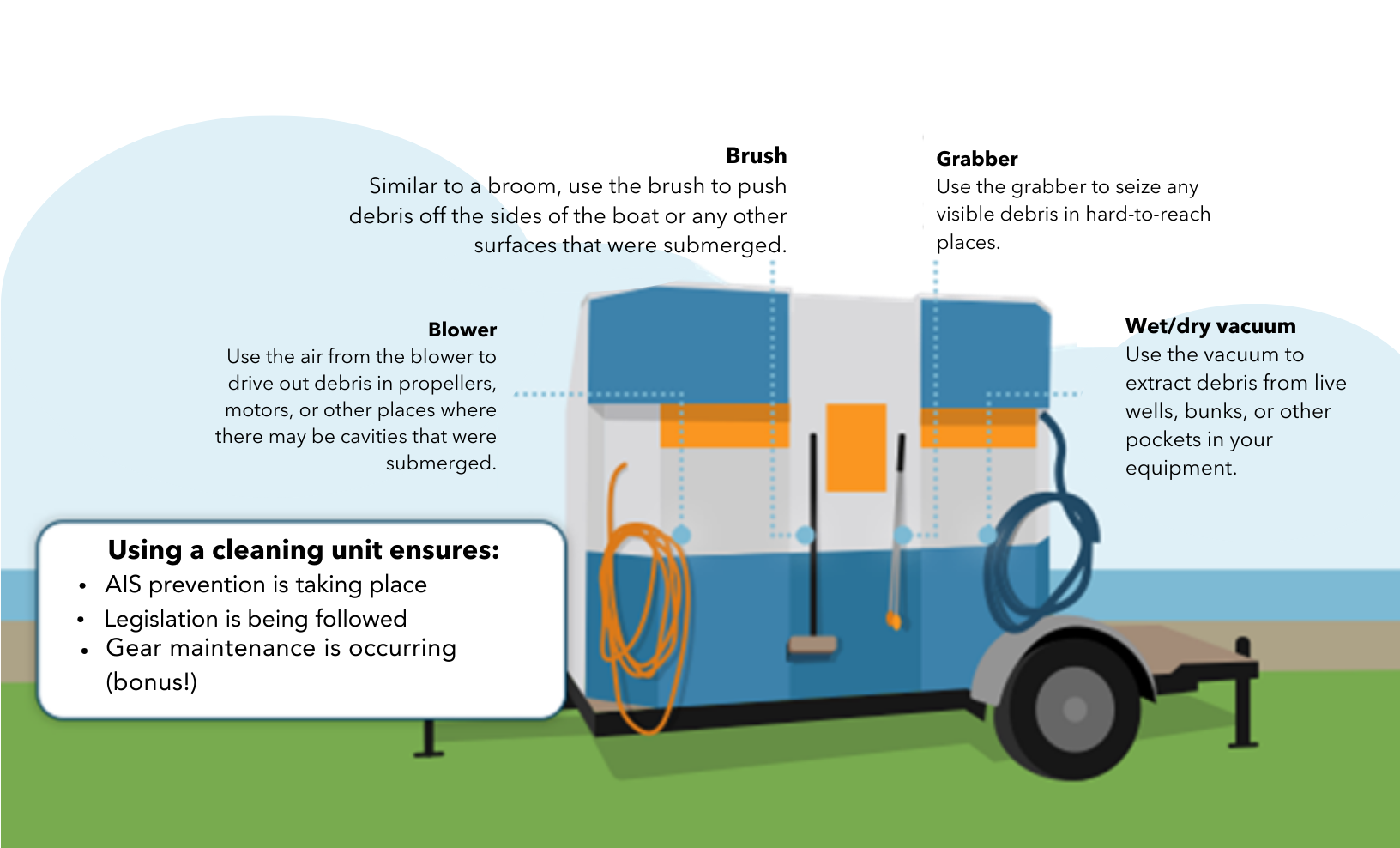February 27, 2024
Invasive species prevention is on wheels in Ontario’s Algonquin Provincial Park! After a disappointing discovery of invasive spiny waterflea at the park, the Invasive Species Centre deployed a Watercraft Cleaning Unit for the 2023 spring/summer season. This solar-powered prevention-mobile provided boaters with tools to properly Clean, Drain, and Dry their watercraft and gear, allowing the safe removal of any aquatic invasive species (AIS) that could otherwise be transported into or from Algonquin lakes.


Algonquin Provincial Park in Ontario captivates millions of visitors annually with its 1000s of lakes and iconic wilderness. That’s why biologists were especially disappointed to find that spiny waterflea had invaded three lakes at the park’s north end. This invasive invertebrate can go unnoticed due to its small size, during which it can outcompete native species for food and damage the biodiversity of native zooplankton communities, resulting in cascading impacts on the entire food web.
Spiny waterfleas also can compromise recreational and commercial fishing. They get caught in fishing equipment and commercial netting and trawling lines, forming jelly-like masses that make it difficult to reel in lines, nets, and trawl lines. In the U.S., restoration costs associated with ecosystem damage caused by spiny waterflea have been estimated at US$86.5-$163 million (Walsh et al., 2016).


A) Invasive spiny waterflea was discovered at Algonquin Provincial Park. Photo credit to Gary Montz, Bugwood.org B) Jelly-like masses of spiny waterfleas get caught in fishing equipment, commercial netting, and trawling lines. Photo from https://www.seagrant.wisc.edu/our-work/focus-areas/ais/invasive-species/invasive-species-fact-sheets/zooplankton-crayfish/spiny-waterflea/
One of the main pathways of spread of spiny waterflea and other AIS is through boating. Invasive species can hitchhike on boats and trailers from one area and be carried along to another, where they can have a significant impact on the environment, society, and economy. AIS can attach to parts of watercraft including the anchor, propeller, dock lines, live wells, bilge, motor, and more. Invasives do not discriminate and can attach to boats ranging in size from a canoe to a barge.
Before the discovery of spiny waterflea in Algonquin, the Cleaning Unit was working its magic cross-country in Alberta – preventing the spread of Chinese mystery snail from Lake MacGregor into neighbouring waterways.
But then, duty called Eastwards! To encourage boaters to clean, drain any standing water, and dry their watercraft and any related equipment to prevent the further spread of spiny waterfleas and other AIS, the Cleaning Unit was transferred to Ontario and positioned at the most high-traffic region of Algonquin Park for watercraft: Costello Lake parking lot area along the route to the Opeongo launch point. It is an ideal place for recreationalists to clean, drain, and dry their boats at the station prior to entering and exiting Costello Lake.
In fact, it’s the law for boaters moving or hauling their boats or gear overland in Ontario to Clean, Drain, and Dry them. The provincial regulations involve simple steps that watercraft users can take to help protect their favourite places from AIS. The Cleaning Unit provides an accessible means for boaters to complete these practices. It includes a wet/dry vacuum, a brush, a blower, and a grabber to remove debris from boat surfaces, motors, propellers, and other places with cavities and hard-to-reach places. The Cleaning Unit fosters responsible boater behaviour in AIS prevention and showcases clean, drain, and dry actions by recreators.


What are AIS?
Aquatic invasive species are fish, invertebrates or plant species that have been introduced into a new aquatic environment outside of their natural range and have the potential to cause environmental, economic, or societal harm in their ecosystem. Their adaptive characteristics give them the capacity to spread and grow in population size, allowing them to outcompete native species for food and space, which can be detrimental to aquatic ecosystems and under and overwater biodiversity. Some AIS also have the capacity to negatively impact infrastructure should they attach to or clog drainage systems.
Examples of notorious AIS include spiny waterflea, zebra and quagga mussels, Eurasian watermilfoil, sea lamprey, and Asian carps, all of which have been responsible for negatively altering the natural environments which they have invaded. Invasive mussels, for instance, filter plankton out of the water, depleting food sources for native species, and allowing in more sunlight which promotes toxic algal blooms and excessive growth of aquatic vegetation. Invasive mussels can also clog water intake pipes and grow on infrastructure such as docks, and their sharp shells can be a health and safety hazard.
What can you do?
Use the Cleaning Unit!
If you see a Cleaning Unit, use it! It is free for public use and a great means for cleaning your equipment from AIS.
Clean, Drain, Dry!
Even if a Cleaning Unit is not available, always clean, drain, and dry your equipment and gear when leaving a waterbody to not unintentionally transport any AIS with you. Make sure you are cleaning every part of your boat, including your equipment.
Report AIS if you see them!
Report any sightings of AIS on the EDDMapS website, or if you’re in Ontario, you can also call the Invading Species Hotline at 1-800-563-7711. If possible, take a photo of the species for reference.
Learn how to identify AIS
The first step to reporting invasives is to be able to identify them. You can learn more about aquatic invasive species on our website.
